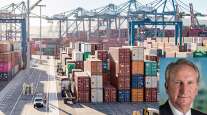SoCal Port Turn Times Fall 7 Minutes in October
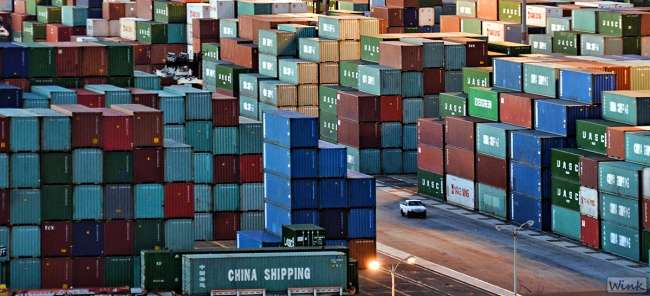
The average time it took a truck driver to enter and exit the major Southern California ports fell 7 minutes in October on a year-over-year basis, according to monthly data from the Harbor Trucking Association.
Ports in Los Angeles and Long Beach accomplished the feat while also keeping up with more containers through the first 10 months of this year compared with 2016.
The turn time across the two ports was 83 minutes. At the Port of Los Angeles, it was 87 minutes. At the Port of Long Beach, it was 76 minutes.
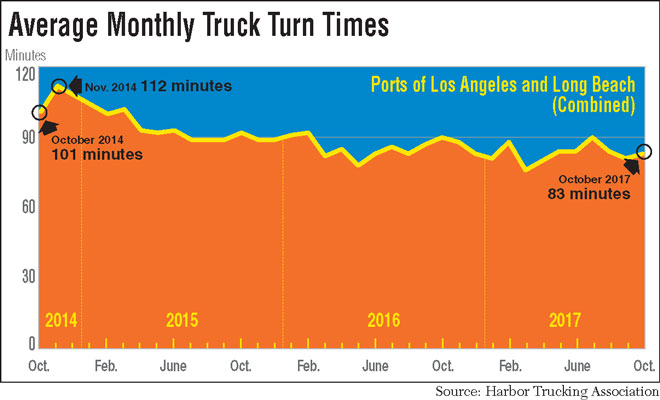
The Harbor Trucking Association and Geostamp use geofencing to calculate the time from when a truck enters the queue outside the entrance to when it crosses the exit gate.
Total Terminals International averaged 91 minutes last month, significantly better than the 123 minutes a year ago. It’s only the fourth time in the last 22 months that TTI was under 100 minutes, although the terminal was still tied for the slowest in Long Beach last month.
HTA Executive Director Weston LaBar told Transport Topics that TTI’s new management team is working with the trucking community to eliminate unnecessary delays.
“Their new approach has been light years better than what it has been in the past, when there was a terminal-centric frame of mind and the trucker was just an afterthought,” he said.
Yusen Terminals International showed significant improvement for the fifth consecutive month. The turn time there was 67 minutes last month — the quickest in Los Angeles — down from 94 minutes in October 2016. The quickest terminals in Long Beach were the lightly used Matson terminal at 36 minutes and the automated Middle Harbor terminal at 39 minutes.
APL’s Eagle Marine Services terminal was the slowest in Los Angeles at 103 minutes. TraPac also struggled with a 97-minute average in October.
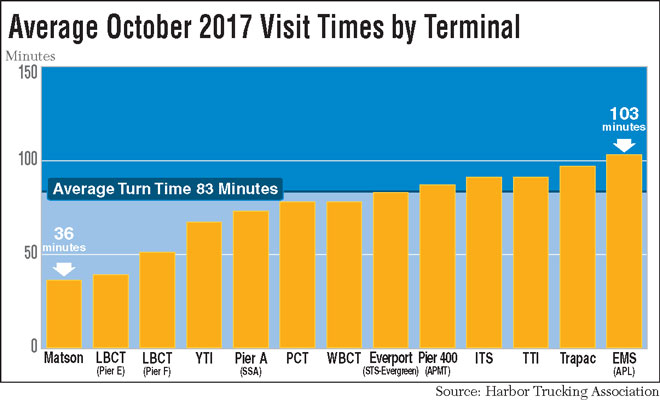
“TraPac uses an off-the-shelf appointment system, which has had problems. Each one of their cranes [putting containers onto trucks] is only supposed to handle 10 trucks per hour, but if you’re a house trucker, then you don’t have to make an appointment. So there are hours where a crane might handle 12, 14, 16 trucks in an hour when it should only be handling 10, which creates unnecessary logjams,” LaBar explained.
House truckers are carriers or owner-operators contracted with the steamship lines to handle land transportation.
The Port of Los Angeles handled 748,762 industry-standard 20-foot-equivalent units, or TEUs, last month. Although that was a drop of 8.1% from the same month a year ago, Los Angeles is still on track to shatter the Western Hemisphere record for a single year. L.A. established the high mark only last year with 8.8 million TEUs.
In October, loaded imports decreased 8.1% to 383,385 and exports decreased 13% to 144,209 TEUs.
Port of L.A. Executive Director Gene Seroka said port workers also set what he believes is a record for a single port of call by moving 24,308 TEUs off and back on the Maersk Evora at APM Terminals.
The Port of Long Beach set an October record with 669,218 TEUs last month, rising 15% from a year ago.
Inbound containers jumped 14% to 339,013, but exports decreased 0.5% to 126,150 containers.
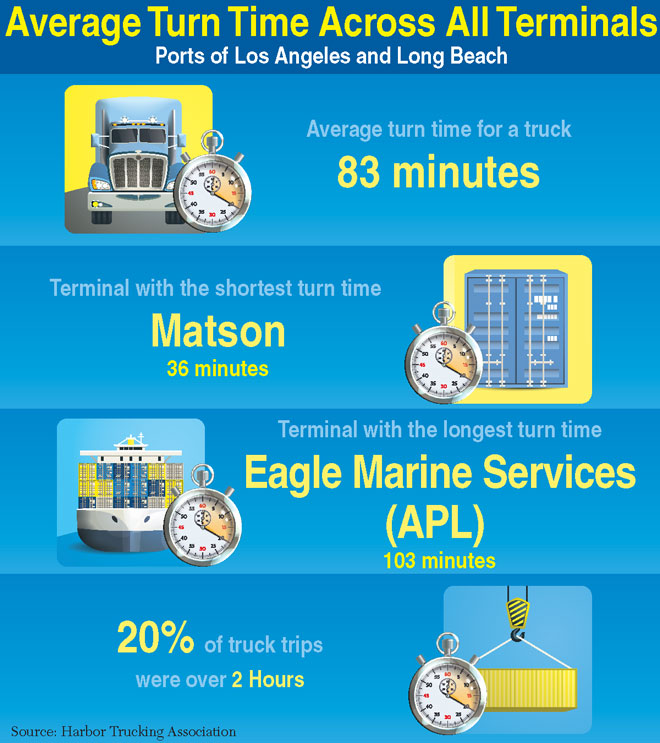
Dockworkers have processed 6.2 million TEUs through October, up 9.5% from the same 10 months in 2016.
“With two months left in 2017, we’re on track to have our best year ever,” Harbor Commission President Lou Anne Bynum said.
Meanwhile, PierPass hired a consulting firm, The Tioga Group, to evaluate the traffic mitigation fee charged during the day hours to pay for evening and Saturday hours at the two ports.
Supporters argue that the fee encourages the pickups and dropoffs when there is less traffic on the road.
Opponents counter that PierPass is an inefficient system that causes bottlenecks during the switch between shifts and is also outdated with well-run appointment systems. They also argue that terminal operators offpeak services, leaving daytime transactions as the only viable option.
With two months left in 2017, we’re on track to have our best year ever.
Harbor Commission President Lou Anne Bynum
There are also concerns about the escalating fees, which increased 2.3% to $72.09 per TEU on Aug. 1.
According to PierPass, the fees were raised six times since its inception a dozen years ago: 2011 through 2013 and 2015 through 2017. PierPass cited a 2015 analysis from KPMG that found 77% of the fee goes to union labor, 11% to nonunion labor, 9% to equipment costs and 3% to administrative overhead. SC Analytics calculated the net costs to operate off-peak shifts totaled $224.7 million in 2016, but the terminals raised only $182.7 million through the fee.
Tioga will analyze the effects of two alternatives to the current system: a flat fee on both daytime and nighttime cargo moves and a portwide peel-off, in which trucks would operate like taxis in an airport queue, picking up the next container in the stack.
Cargo owners and trucking companies have balked at the second option because it would introduce an element of the unknown regarding who exactly is picking up their container.
Recommendations and a final report are expected during the first quarter of 2018.


